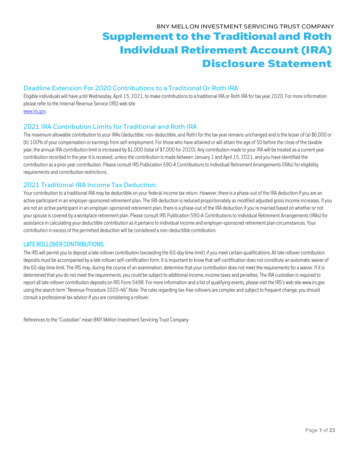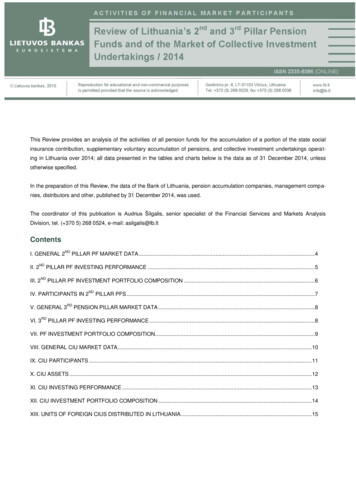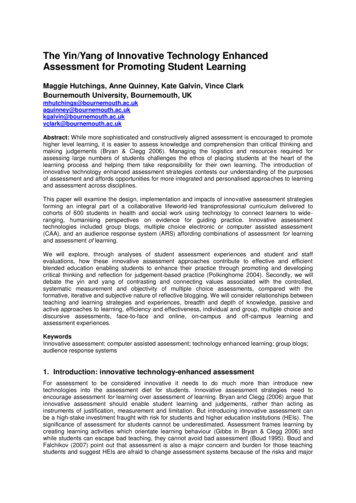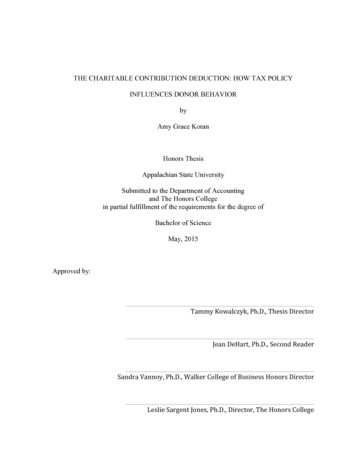
Transcription
Assessment of the contribution of assisted reproduction methods for the futuredevelopment of the number of live births in CzechiaBoris BurcinCharles University, Faculty of Science, Prague, Czech Republic: boris.burcin@natur.cuni.czTereza PachlováCharles University, Prague, Faculty of Science, Czech Republic:tereza.pachlova@natur.cuni.czAnna ŠťastnáCharles University, Prague, Faculty of Science, Czech Republic: stastna@natur.cuni.czJiřina KocourkováCharles University, Prague, Faculty of Science, Czech ing authorJiřina Kocourková, Charles University, Faculty of Science, Albertov 6, Prague 2, CzechRepublic: The key demographic trend concerns the postponement of parenthood to later ages. Moreover,the number of Czech women of reproductive age is decreasing, which will lead to a decreasein the number of live births even with higher fertility. The aims are to assess recent trendsconcerning using ART in Czechia and to estimate the impact of using ART on the futuredevelopment of the number of live births.19
Methods:Based on data on the number of ART cycles involving the transfer of embryos in the period2007–2012, the number of deliveries following ART was converted to the number of livebirths following ART by the maternal age at birth for the period 2008-2012. Subsequently,age-specific fertility rates following ART and models of the potential future development oflive births following ART treatment were calculated. These models were based on acombination of two potential fertility development variants and four variants for theestimation of the future share of ART fertility of total fertility by age (V1-V4).Results:If the use of ART methods remains unchanged, there will be a decrease in the number of livebirths following ART in the period up to 2030 (V1 and V2) due to the declining reproductivepotential of women. An increase in the number of live births following ART would occuronly if there were an increase in the use of ART methods. Depending on the expected level ofthe increase in the use of ART, the number of live births following ART would increase by2030 to 4.9 thousand (V3) and 6.5 thousand (V4). In relative terms, this would represent anincrease from the initial 3.2% of the total number of live births to 5.0% and 6.8%respectively.Conslusions:We can expect an increase in the importance of ART for demographic trends in the future.The projection models assumed that the future development of the use of ART would beaffected not only by the intensity of fertility postponement and different levels of fertility, butalso by advances in reproductive medicine and the increasing availability of ART.Keywords: assisted reproduction, fertility, postponement of childbearing, infertility,projection,Plain English SummaryThe number of couples who are unable to realise their wishes to have children is expected toincrease due to the continuous postponement of parenthood to later ages. As a result,increasing numbers of women are opting for assisted reproductive technology (ART)treatment in most European countries and, in particular, in Czechia. Moreover, since ART isrelatively easily accessible and cheap in Czechia, the country’s assisted reproduction centres19
are attracting intensive reproductive tourism. The aims of the study are to assess recentdemographic trends concerning the use of ART in Czechia and to estimate the impact of itsuse on the future development of the number of live births. If the use of ART methodsremains unchanged, there will be a decrease in the number of live births following ART in theperiod up to 2030 due to the declining reproductive potential of women. An increase in thenumber of live births following ART will occur only if there is a corresponding increase inthe use of ART methods. Depending on the expected level of the increase in the use of ART,the number of live births following ART will increase from an initial 3.5 thousand to amaximum of 6.5 thousand by 2030. In relative terms, this would represent an increase from aninitial 3.2% of the total number of live births to 6.8%. Our results document an increase in theimportance of ART in terms of future demographic trends.BackgroundRecent decades have witnessed a large number of changes in terms of reproductive behaviourin all European countries. One of the most significant trends concerns the postponement ofparenthood to later ages, in connection with which populations are being faced with a newproblem, i.e. an increasing number of couples who are unable to realise their wishes to havechildren. A slow but steady decline in fecundity commences as early as women reach the ageof 30, with a sharp decline from the age of 35 [1, 2]. According to estimates, an increase inthe age at which women attempt their first pregnancy of 2.5 years leads to a decrease infertility of around 5% from the age of 25 onwards [3]. The results consist not only ofincreasing rates of childlessness but also an increase in the proportion of multiple births [4].Czechia is one of a number of countries that has seen the particularly intensive postponementof fertility by women to older ages over a relatively short period [5]. The most rapid increasein the mean age of women at first birth occurred from the early 1990s (22.5 years) to 2006 (27years). Subsequently, the increase slowed and is currently approaching 29 years of age. At thesame time, it has been determined that fertility postponement increased by 3% in Czechia [6].Compared to other European countries, Czechia also recorded the greatest increase in multiplepregnancies [4].The combination of the postponement of pregnancy and declining fecundity with age isleading to an increasing number of women opting for assisted reproductive technology (ART)treatment. According to the latest data, between 1% and 6% of all live births in Europe followART treatment and these proportions are increasing steadily [7]. Furthermore, over the last19
two decades, Czechia has evinced one of the most rapid increases in Europe in this respect[8]. Assisted reproduction has been available in Czechia since 1997, at which time legislationwas introduced allowing women under the age of 39 to undergo 3 ART cycles financed fromthe public health insurance system. Thus, it can be assumed that ART methods have becomean important factor in terms of fertility trends in Czechia [9, 10, 11].While assisted reproduction has often been assessed in terms of the inherent health risks andthe various consequences for the health of both the mother and the child [12], demographicapproaches are rare since it is difficult to access reliable data. The aim of the article is toassess recent trends concerning the use of ART in Czechia and, subsequently, to estimate theimpact of ART on the future development of the number of live births, especially inconnection with delayed fertility, the expected growth in infertility and the changing agestructure of women of reproductive age. Unique data was accessed for the period 2008-2012,the definition of which was related to two significant legislative changes. In 2006, theobligation was introduced for all reproduction centres to submit data on ART treatment cyclesto the Czech Institute of Health Information and Statistics (IHIS), which led to the creation ofa national register in which complete data has been recorded since 2007. In Czechia the fieldof reproductive medicine is currently regulated by Act No 373/2011 of the Code relating tospecific health services and Law No 48/1997 of the Code of public health insurance [13, 14].The Act No. 373/2011 on specific health services, introduced the funding of a fourth ARTcycle for women up to the age of 39 provided that only one embryo was transferred in each ofthe first two cycles. Our findings will contribute both to the refinement of the futureestimation of the needs associated with newly-created population development forecasts andthe estimation of future requirements concerning the capacity of reproduction centres inCzechia. At the application level, the results can be employed in the drafting of legislation onART treatment, since the legislative availability of ART comprises a significant factor interms of the demand for this type of treatment.Data and MethodsDataData on ART in Czechia was obtained from the National Register of Assisted Reproduction(NRAR) which is administered by the Institute of Health Information and Statistics of the19
Czech Republic (IHIS). The register records information on all women who have undergoneovarial stimulation or monitoring for the treatment of sterility by means of IVF [15].The analysis is based on data on the number of ART cycles involving the transfer of embryos1according to the number of transferred embryos and the completed age of women in theperiod 2007–2012 and the number of deliveries that resulted from these cycles (which tookplace from approximately 1 October 2007 to 30 September 2013). In order to determine theimportance of ART methods in terms of births and to calculate the demographic fertilityindicators of ART treatment, it was necessary to convert the number of deliveries followingART to the number of live births and to convert the ages of women and the date of embryotransfer to the maternal age and year of birth.The transition from the age and year of embryo transfer to the age and year of childbirth isshown below in the form of a Lexis diagram (Fig. 1). The numbers of children born datedaccording to the time of embryo transfer (the grey shaded square) were shifted by 9 months interms both of the mother’s completed age and the year (red square).Fig. 1: Conversion of births from the year/age at ART to the year/age at birth1Via the IVF, ICSI (intracytoplasmic sperm injection) or FET (frozen embryo transfer) methods.19
This conversion method includes several assumptions:1) births following ART exhibit the same rate of stillbirths as births conceived without the useof ART methods according to the age of the woman and to parity.2) ART cycles, their rate of success and resulting births are distributed evenly throughout thecalendar year.3) all the pregnancies lasted for the standard period of 9 months (40 weeks).The application of this input data transformation method resulted in the estimation of thenumber of children born in a given calendar year following the use of ART methodsaccording to the age of the mother for the period 2018-2012.It was important for the research that only data concerning women with Czech citizenship wasused in the analytical and model calculations. Due to the fact that ART is relatively easilyaccessible and cheap in Czechia, the country’s assisted reproduction centres attract intensivereproductive tourism. In 2012, approximately 16.5% of all IVF cycles and 35.8% of FETcycles concerned foreign women, and 85.2% of the women registered for the acceptance ofdonated oocytes were of non-Czech citizenship [16]. According to a survey conducted by theEuropean Society of Human Reproduction and Embryology [17], over 67% of women fromGermany and over 50% of women from the United Kingdom of those who received ARTtreatment abroad in 2008 – 2009 chose services provided in Czechia.A certain limiting factor of the data employed concerns the fact that the numbers of birthsentered in the assisted reproduction register are based solely on the data provided by assistedreproduction centres and are, therefore, likely to be underestimated. Since, following anamendment to legislation, the obligation to enter the woman’s identification number wasabolished and data was collected in an anonymised form during the period 2010 – April 2012,it is, unfortunately, not possible to validate such data and thus to quantify the extent ofunderestimation.Information on the age structure of women and live births according to the age of the motherwas obtained from data provided by the Czech Statistical Office [18].MethodsStandard demographic indicators were employed in order to assess the importance of the useof ART with respect to births in Czechia, i.e. the total fertility rate (TFR), age-specific fertility19
rates and the mean age of women at birth, which were calculated only from births followingART treatment.Age-specific fertility rate following ART (whererepresents the number of live births to mothers at age x following ART andrepresents the mid-year population of women at age x.Total fertility rate following ART ():where xmin 15 and xmax 49.Mean age of women at birth following ART (With respect to the assessment of the potential future impact of the use of ART methods onfertility in Czechia for the period 2013-2030, we employed the medium variant parameters ofthe expected development of fertility, mortality and migration as set out in an unpublishedforecast of the development of the Czech population [19] based on the country’s population asat 31 December 2012.The models of the potential future development of live births following ART treatment werebased on a combination of two potential fertility development variants (a) the fixing of agespecific fertility rates at the 2012 level and (b) the medium fertility variant from the Burcinand Kučera forecast2 [19], and four variants for the estimation of the future share of ARTfertility of total fertility by age.The first variant (V1) of the estimate of ART live births works with a constant total fertilitylevel (the age-specific fertility rates of women are fixed at the level of 2012) and the share of2After a time period of several years, the medium variant of this fertility development forecast has proved to bevery accurate; with respect to the period 2013-2019, it corresponds well to the actually observed development offertility in Czechia.19
ART fertility of total fertility (the share of ART fertility of total fertility at various agesremains at the level of the average for 2011–20123). Thus, this variant primarily illustrates theimpact that the changing age structure of women of reproductive age would exert on thenumber of ART live births (and also, generally, on the use of ART) if the development of theoverall fertility level and the use and success rate of ART were unchanged. It thusdemonstrates the reproductive potential embedded in the age structure and the number ofwomen in individual generations.The other three model variants work with the medium variant of the total fertilitydevelopment forecast for the Czech Republic for the period 2013-2030 rather than with thefixed 2012 value. This total fertility development variant is combined with three potentialscenarios of the development of the use and success rate of ART treatment:a) the share of ART fertility by age of overall fertility by age remains the same as the 2011–2012 average level. The future development of the number of ART births according to thisvariant is thus primarily influenced by the expected development of total fertility as well asthe changing age structure of women of reproductive age.b) a steadily increasing share of ART of total fertility of up to 1.5 times the average of 2011–2012 by 2030. In this case, the expected increase in the availability of ART methods(including the enhanced success of ART treatment) and increasing infertility due to thecontinuing trend of an increase in the mean age of women at childbirth were taken intoaccount. Support for the assumption of an increasing share of ART births of total fertility isprovided by the share of ART live births in countries with highly-developed ART treatmentinfrastructures and older mothers at childbirth - e.g. more than 6% of live births followedART treatment in Denmark in 2012 [20].c) a variant that considers the upper limit of the increase in the share of ART, i.e. up to twicethe level of the reference period 2011 to 2012 assuming the broad availability of ARTmethods due to intensive technological development and significantly increasing infertilitylevels.The variants concerning the potential development of the contribution of ART to the futuredevelopment of the birth rate in the Czech Republic can thus be summarised as follows:3We worked with the average for 2011 and 2012 in the model calculations of the potential future developmentof ART fertility so as to compensate for partial fluctuations caused by the lower absolute numbers of events inindividual age categories. Moreover, this average was smoothed for the projection calculations since a partialfluctuation observed in one year could, over a time period of 17 years, lead to significant disparities in theprojection model.19
– V1: a constant share of smoothed age-specific fertility rates following ART based onthe period 2011–2012 plus fertility rate values fixed at 2012 levels– V2: a constant share of smoothed age-specific fertility rates following ART based onthe period 2011–2012 plus the medium fertility forecast variant– V3: an increasing share of smoothed age-specific fertility rates following ART (anincrease of 50% by 2030 compared to the average of 2011–2012) plus the mediumfertility forecast variant– V4: an increasing share of smoothed age-specific fertility rates following ART (anincrease of 100% by 2030 compared to the average of the 2011–2012 referenceperiod) plus the medium fertility forecast variant.ResultsTrends in the use of ART in Czechia in the period 2008-2012During the period 2008–2012, the number of ART cycles performed in Czechia ranged from12,300 to 13,500 per year. The number of births following these cycles ranged between twoand three thousand during the observed period and increased over time (Tab. 1).In the same period, an increasing trend towards ART single-embryo transfer is evident, whichwas supported in 2011 by the introduction of a reimbursed 4th cycle provided that only 1embryo had been transferred in the first two cycles. While in 2008 two or more embryos weretransferred in 80% of ART cycles, by 2012 the proportion had decreased to just half of ARTcycles (Tab. 1).Tab. 1: Trends in the use of ART in the period 2008-2012Number of ART cycles*Number of ART deliveriesProportion of ART cycles with 2 or moretransferred embryos (in %)Number of live births following ARTShare of live births following ART (in 202.442,8352.402,8952.473,6343.343,2723.01Note: *number of IVF, ICSI and FET embryo transfer cycles.19
However, despite a significant decrease in multiple pregnancies, the number of live birthsconceived using ART increased from less than 3,000 from cycles performed in 2008 to 3,600from cycles performed in 2011. In relative terms, there was an increase in live birthsfollowing ART of the total number of live births from 2.4% to 3.3%. The slight decreaserecorded in 2012 may have been related to an amendment to tissue and organ donationlegislation, which abolished the obligation to register the woman’s identification number frommid-2010 to its re-introduction in 2012, and which may have led to a disruption in datacontinuity and the loss of information on the results of ART treatment [21].The use of ART in Czechia in the period 2008-2012 in the light of demographic indicatorsThe age-specific fertility rates following ART (Fig. 2) reveal that in Czechia the highestvalues concern those aged between 30 and 34 years. A clear increase in the fertility ratefollowing ART commences after the age of 26. A significant decrease is then observed at theage of 35; after the age of 40, fertility rates following ART decrease to negligible values,which is closely linked to the end of the payment of ART treatment by the public healthinsurance system.Between 2008 and 2011, a slight decrease in, and stagnation of, fertility rates following ARTis evident up to the age of 28. However, after the age of 29 a significant increase can beobserved especially in 2010 and 2011, which was spread over a wide age range, and fertilityrates increase every year up to the age of 40. This is also reflected in the increasing mean ageof women at birth following ART, i.e. by almost one year in a period of just five years (from32.5 in 2008 to 33.4 in 2012). This represented a significantly more dynamic increase thanthat of the total mean age of women at birth, which increased by 0.5 years over the sameperiod. Moreover, mothers following ART were, on average, around 3.5 years older, i.e. themean age of all mothers was 29.3 in 2008 and 29.8 in 2012 [22].The total fertility rate following ART (TFRART) increased from 0.035 in 2008 to 0.045 in2011 and subsequently decreased slightly to 0.041 in 2012. Due to the overall decrease in theTFR in the period under study, the relative importance of ART increased - while in 2008 theTFRART represented 2.3% of the TFR, it had risen to 3.2% by 2011 and stood at 2.8% in 2012.19
Fig. 2: Fertility rates, mean age of women at birth and total fertility rate following ART in2008–2012Projections – reflection of the model assumptions concerning the demographic indicatorsof ART developmentAs follows from the description of the projection variants in the methodology section, theoptions regarding the future development of ART fertility suggest an increase in the agespecific fertility rate following ART compared to the period 2011-2012 due to both increasinglevels of total fertility and the increasing importance of ART fertility in older age groups (Fig.3). The exception in this respect concerns variant 1, which works with fixed total fertility ratesand a fixed share of ART fertility of total fertility. It is clear from Fig. 3 that the differencebetween the initial state and the estimated state in 2030 assuming unchanged fertilityintensities would be minimal; any partial differences would be the result merely of thechanging structure of women according to age.With respect to variant 2, which considers the constant distribution of the share of ARTfertility rates of the total fertility by age over the whole of the studied period, the projecteddevelopment is influenced by the expected increase in the total fertility level which, according19
to this variant option, would lead to an increase in the absolute age-specific fertility ratefollowing ART as well as the TFRART (increase from 0.043 in 2011-2012 to 0.055 in 2030,see Fig. 3).According to variants 3 and 4, the share of fertility rates following ART of total fertility ratescan be expected to increase by approximately 50% and 100% respectively by 2030 comparedto the reference period of 2011-2012. If one considers the increasing share of ART fertilityrates together with the medium total fertility forecast variant, the resulting fertility ratesfollowing ART and thus also the TFRART will be significantly higher, reaching 0.082 and 0.11by 2030 according to variants 3 and 4 respectively. The projected fertility rates include theexpected trend of a continuous increase in the age of mothers at childbirth, which is alsoreflected in a visible shift in fertility rates following ART to older ages in variants 2 to 4.Fig. 3: Fertility rates following ART: average for 2011-2012 and expected development in2020 and 2030The importance of a further shift in the mean age of women at childbirth is evident when oneconsiders the share of ART fertility rates of overall fertility rates for selected age groups (Tab.2). Not surprisingly, this proportion increases significantly with the age of the mother atchildbirth. As already mentioned, not only does a woman’s ability to conceive decrease with19
age, but it can also be expected that up to a certain age, most women try to conceive naturallyand, therefore, are less interested in assisted reproductive treatment. With respect to the 35-39age group, the share of fertility rates following ART of overall fertility exceeded 6% in theperiod 2011–2012. Assuming the constant share of ART fertility rates from the period 2011–2012 and the fixed fertility rate values of 2012 (variant 1), logically no significant changesshould occur in this distribution throughout the observed period. However, conversely, withrespect to variant 2 the combination of the fixing of the share of ART fertility rates and theprojected increase in overall fertility according to the medium forecast variant will result instabilisation at age 35-39 and a slight decrease in the oldest age group.The remaining two variants that assume an increase in the proportion of ART fertility (V3 andV4) which is evenly distributed throughout the female reproductive period indicate, inter alia,that in this case the share of ART fertility rates of overall fertility rates after the age of 35would be around 9% and 13% respectively in 2030 for variant 3 and more than 12% and 17%respectively in 2030 for variant 4.Tab. 2: Expected development of the share of ART fertility rates of overall fertility rates byagePercentage of fertility rates following ART (in 7.6112.4217.39In order to analyse the overall future significance of ART for childbirth, it is also necessary toconsider the numbers of women who will enter the age at which ART is most oftenperformed, i.e. the so-called reproductive potential of women. According to the populationforecasts for Czechia used in this article [19], the number of women aged 20–39 will decreasein the period 2012–2030, with no significant numerical change in the 40–49 age group (Fig.4). Compared to the projection threshold, there will be a significant decrease in the number ofwomen especially in the 30–34 (by 32%) and the 35-39 (by 27%) age groups, whereas the 20–29 age group is expected to see a decrease of 14%. Since, clearly, this represents a significantreduction in the number of women who could, theoretically, receive ART treatment, these19
developments should be taken into account when evaluating the total number and share of livebirths following ART.Fig. 4: Expected reproductive potential of women in the period 2012–2030 (selected agegroups)Results of the projection estimates - development of the number of live births followingARTThe results of the calculations for all the considered ART fertility development variants revealtwo fundamental findings. Due to the declining reproductive potential of women (cf. Fig. 4),if the use of ART methods remains unchanged there will be a decrease in the number of livebirths following ART in the period up to 2030 (Fig. 5). This decrease would be mostpronounced if neither the use of ART nor the total fertility level changed over the observedperiod (Fig. 6 - V1). Moreover, according to the medium variant of the fertility forecast, eventhe expected increase in the total fertility level would be insufficient to stabilise, let alone leadto an increase in the number of children born following ART at the end of the period underobservation (Fig. 6 - V2). With concern to this decrease, it is necessary to bear in mind the19
overall decrease in the number of live births that will, undoubtedly, occur during the periodunder study even with increasing total fertility levels (cf. Fig. 6 - V2-V4 “total” category)since it is deeply embedded in changes in the age structure and decline in the overall numberof women of reproductive age.An increase in the number of live births following ART would occur only if there were anincrease in the use of ART methods (Fig. 6). Depending on the expected level of the increasein the use of ART, this development would be relatively significant and constant; by 2030, thenumber of live births following ART would increase from the initial 3.5 thousand to 4.9thousand and 6.5 thousand according to variants 3 and 4 respectively (Fig. 5). In relativeterms, this would represent an increase from the initial 3.2% of the total number of live birthsto 5.0% (V3) and 6.8% (V4) in 2030 (Fig. 6).Fig. 5: Expected development of the number of live births following ART in the period2013–203019
Fig. 6: Expected development of the number of live births and the share of ART live births,2013–2030DiscussionThe main contribution of the article concerns the evaluation of trends in the use of ARTaimed at estimating its impact on the future development of birth rates based on the exampleof Czechia. The prognostic approach to the analysis of ART has, to date, been applied onlyrarely in the expert literature. A major problem in this respect consists of the absence of dataon age-specific fertility rates following ART, which is essential when attempting to assess theimpact of the use of ART on birth rates. At present, the authors are not aware of any otherstudy that has addressed the estimation of the expected development of ART over the longerterm.19
The only similar study published to date concerns the estimation of the development of theuse of ART in Denmark [11]. The authors projected the complete cohort fertility followingART of Danish women born in the 1960s and 1970s. They assumed more fertilitydevelopment variants and two scenarios of the development of the use of ART - a constantshare of births following ART according to age and the extrapolation of the trend in ART use.The analysis concluded that the completed fertility of women from the 1960s and 1970sgenerations increased by an average of 0.05 children per woman as a consequence of ARTuse. While our data did not allow us to determine the cohort fertility level, it was possible toconclude that ART contributed to total fertility rate in Czechia by only a slightly lower valuethan in Denmark, i.e. 0.034–0.045 in the period 2008–2012 (Fig. 3). These results areconsistent (considering developments over time) with the findings of other study [9], where itis argued that if the use of ART in the UK incre
2007-2012, the number of deliveries following ART was converted to the number of live births following ART by the maternal age at birth for the period 2008-2012. Subsequently, age-specific fertility rates following ART and models of the potential future development of live births following ART treatment were calculated.











